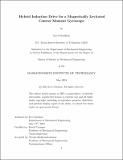Hybrid Induction Drive for a Magnetically Levitated Control Moment Gyroscope
Author(s)
Gershon, Levi
DownloadThesis PDF (11.86Mb)
Advisor
Trumper, David
Terms of use
Metadata
Show full item recordAbstract
In order to support future astronautical missions, in light of the rapid growth of miniaturized smaller satellites, lower jitter and higher torque density multi-axis attitude control systems (ACS) will be needed [1]. This thesis aims to create a hybrid-drive reaction sphere with a spherical 1.5” diameter, diametrically magnetized grade N42 NdFeB rotor. A permanent magnet drive is used for vertical translation control, and an induction drive is used to spin the magnet about its axis of magnetization. Future work can then add more axes of permanent magnet drives to enable control about the other translation and rotation axes, such as was done in [2], setting the stage for full six-axis control of a monolithic rotor.
In this work, analytic models for both magnetic levitation of the rotor and the dipole-field induction are developed, leveraging previously reported models. Additionally, the gyroscopic precession potentially induced by a rotating dipole field is analyzed and determined to be negligible. A benchtop prototype of the system was designed, fabricated, and assembled, where a solenoid is used to magnetically levitate the rotor using its magnetization, and an induction motor is used to spin the rotor about its axis of magnetization. An optical sensor previously developed for position sensing was adapted for spin measurements at high speeds by creating an optical encoder pattern on the rotor. Speeds up to 401 RPM and a torque up to 3.0 μNm were measured, with no significant nutation observed, indicating such a hybrid drive may be a viable architecture for future reaction sphere ACS designs requiring both rotor simplicity and 6 axes of control.
Date issued
2024-05Department
Massachusetts Institute of Technology. Department of Mechanical EngineeringPublisher
Massachusetts Institute of Technology